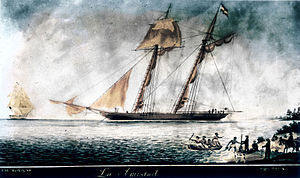Washington (1837)
 USS Washington at left and La Amistad
| |
| History | |
|---|---|
| Name | Washington |
| Namesake | Peter G. Washington |
| Ordered | 6 July 1837 |
| Christened | 1 August 1837 |
| Completed | 1837. |
| Commissioned | before November 1837 |
| Decommissioned | after June 1861 |
| Fate |
|
| General characteristics | |
| Displacement | 190 tons |
| Length | 91 ft 2 in (27.79 m) |
| Beam | 21 ft 2 in (6.45 m) |
| Propulsion | Sail. |
| Sail plan | Topsail schooner; re-rigged as a brig in 1838 |
| Armament | 10 guns (pre-1860); 1 × 42-pound pivot (1860) |
Washington was a

Washington was the second
Service history
Authorized on 6 July 1837 and named on 1 August 1837, Washington was built for the U.S. Revenue-Marine under the supervision of Captain H. D. Hunter, U.S. Revenue-Marine.
While sounding for the U.S. Coast Survey between
Washington was transferred to the United States Coast Survey (later renamed the United States Coast and Geodetic Survey, one of the ancestors of today's National Oceanic and Atmospheric Administration), on 23 April 1840. For the next 12 years, she operated under the aegis of the U.S. Navy off the U.S. East Coast on surveying and sounding duties. While stationed in the Chesapeake Bay in 1846, she was dismasted in a severe gale. Battered and worn but still afloat, she limped into port. She had lost 11 men overboard in the storm, including her commanding officer, Lieutenant George M. Bache.
When the
Returned to the Treasury Department on 18 May 1852, Washington underwent extensive repairs at New York which lasted into the early winter. Alterations were completed on 9 December 1852. Washington remained in the New York area, where she operated locally for the next six years. In the second week of January 1854, Washington, and five other revenue cutters sailed almost simultaneously from their home ports, ranging from New London, Connecticut, to Wilmington, Delaware, and from Norfolk, Virginia, to New York City, in a search for the foundering steamer SS San Francisco. Unfortunately, none of the ships found San Francisco.
Ordered to the
On 25 April 1862, Confederate forces
See also
- Union Navy
- Union Blockade
- United States Revenue Cutter Service
- United States Coast Guard
- List of United States Navy ships
References
- ISBN 0-517-00487-9
- ^ "NOAA History - Peter G. Washington". National Oceanic & Atmospheric Administration. 2013. Archived from the original on 15 January 2009. Retrieved 3 August 2013.
- ^ a b "Washington, 1837". U.S. Department of Homeland Security, U.S. Coast Guard, U.S. Coast Guard Historian's Office. Retrieved 16 November 2023.
- ISBN 978-0-8071-3274-6, p. 75.
- This article incorporates text from the public domain Dictionary of American Naval Fighting Ships. The entry can be found here.
 This article incorporates public domain material from websites or documents of the United States Coast Guard.
This article incorporates public domain material from websites or documents of the United States Coast Guard.
